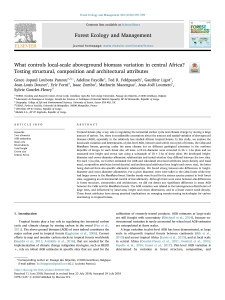Loubota Panzou G. J., Fayolle A., Feldpausch T. R., Ligot G., Doucet J.L., Forni E., Zombo I., Mazengue M., Loumeto J.J., Gourlet-Fleury S.
Tropical forests play a key role in regulating the terrestrial carbon cycle and climate change by storing a large amount of carbon. Yet, there is considerable uncertainty about the amount and spatial variation of aboveground biomass (AGB), especially in the relatively less studied African tropical forests. In this study, we explore the local-scale variation and determinants of plot-level AGB, between and within two types of forests, the Celtis and Manilkara forests, growing under the same climate but on different geological substrates in the northern Republic of Congo. In each forest site, all trees ≥10 cm diameter were censured in 36×1-ha plots and we measured tree height and crown size using a subsample of 18×1-ha of these plots. We developed heightdiameter and crown-diameter allometric relationships and tested whether they differed between the two sites.
For each 1-ha plot, we further estimated the AGB and calculated structural attributes (stem density and basal area), composition attributes (wood density) and architectural attributes (tree height and crown size), the latter being derived from site-specific allometric relationships. We found strong between-site differences in heightdiameter and crown-diameter allometries. For a given diameter, trees were taller in the Celtis forest while they had larger crown in the Manilkara forest. Similar trends were found for the sixteen species present in both forest sites, suggesting an environmental control of tree allometry. Although there were some between-site differencesin forest structure, composition and architecture, we did not detect any significant difference in mean AGB between the Celtis and the Manilkara forests. The AGB variation was related to the heterogeneous distribution of large trees, and influenced by basal area, height and crown dimensions, and to a lesser extent wood density. These forest attributes have strong practical implications on emerging remote-sensing technologies for carbon monitoring in tropical forests.
Consultez la notice complète de l’article sur ORBi

